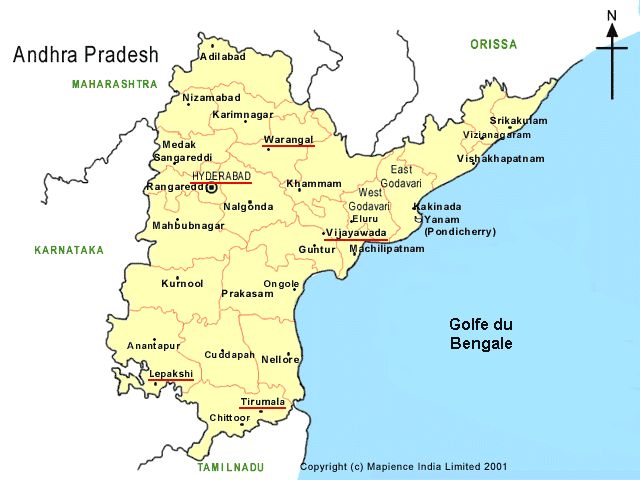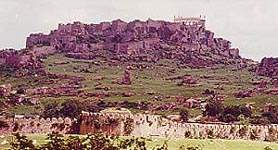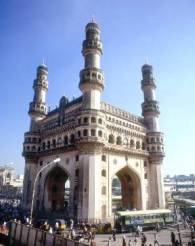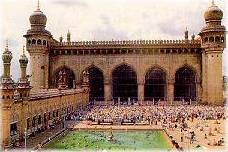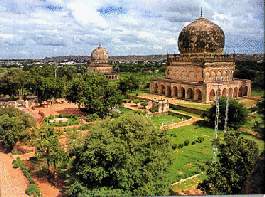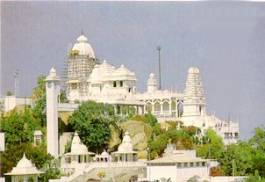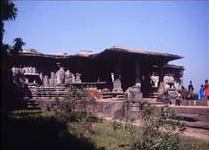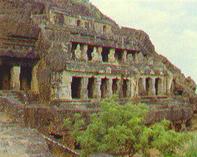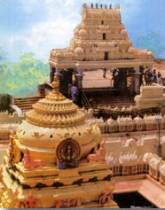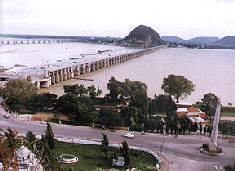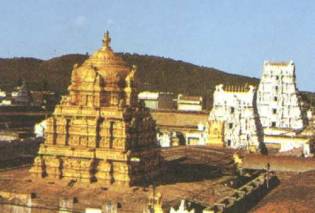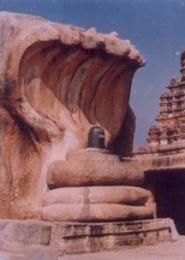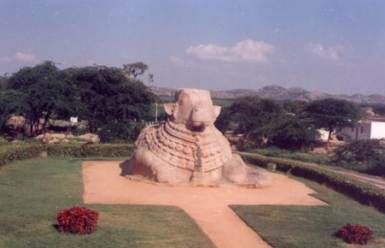Andhra Pradesh is home to more than 75 million inhabitants in an area of 276,754 km2. Its capital is Hyderabad and the official language is Telugu. The state derives its name from a tribe that occupied the region more than 1000 years before J.-C. Andhra Pradesh is mainly rural (80% of the population). The plains are very fertile because well irrigated by the great rivers that cross the state. Andhra Pradesh is the largest rice producer in India. It also produces tobacco as well as many varieties of fruit.
History
The earliest accounts of the region of Andhra Pradesh date back to the great king Maurya, Ashoka (3rd century BC). At the time Andhra Pradesh was a great center of Buddhism. The Satavahama, the Ikshvaku, the Pallava, the Chalukya, the Chola, successively took possession of these territories between the 2nd and the 10th centuries. The Kakatiya built their empire on the ruins of the Chola. They were the ones who had to face the Muslim troops from the north. They resisted until 1323, when the Sultanate of Delhi took over the region. In the middle of the 16th century the Qutb Shahi dynasty emancipated itself and founded the city of Hyderabad. In 1687 the Mughal troops of Aurangzeb seized the fortress of Golconda and Hyderabad. The region remained under Mughal administration until 1724. At that time the viceroy Asaf Jahi created an independent state and took the title of nizam. The nizams were able to maintain a relative autonomy from British imperialism through a subtle set of alliances. In the struggle for independence Andhra Pradesh played an important role. The state entered the Indian Union in 1947 but was not created in its present form (on linguistic criteria) until 1956.
Map of the province of Andhra Pradesh
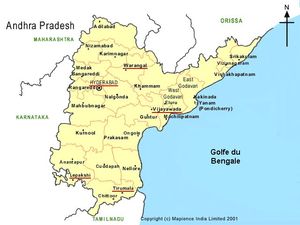
Map of Andhra Pradesh
Hyderabad
With its 4.3 million inhabitants, Hyderabad is the capital of Andhra Pradesh. The city was founded at the end of the 16th century by Mohammed Quli, fifth ruler of the Qutub Shahi dynasty, during a water shortage at the fortress of Golconda. Strategically located, it attracted the covetousness of the Mughals who eventually took it in 1687 during the reign of Aurangzeb. The city was now ruled by a viceroy appointed by the Mughal authorities. It was one of them, Asaf Jahi, who, taking advantage of the decline of the Mughals, proclaimed Nizam in 1724 and decreed the independence of the region. Hyderabad thus regains its status as capital and its prosperity. In 1798 the nizam signed an alliance with the British India Company which was able to establish a cantonment at Secunderabad so named in honor of the nizam Sikander Jahi. In 1947 the nizam then joined the Indian Union.
Hyderabad is renowned for its pearl market.
The fortress of Golconde
This impressive fortress, whose origins date back to the Kakatiya (12th century), was built on top of a 120-meter high hill. Most of the buildings date from the 16th and 17th centuries and were brought by the kings of the Qutub Shahi dynasty. The enclosure wall with its 87 bastions is 5 km long and is pierced with massive doors themselves made to withstand the most violent assaults. The fortress was only taken in 1687 by the Mughal troops of Aurangzeb.
The builders of the fort had developed an ingenious system of water pipes. Other pipes were built with the aim of returning the echoes of a possible enemy intrusion. Formerly famous for its diamond market, the Golconda fortress has seen the birth of the world's largest diamond, the "Kohinoor", which adorns the crown of the British sovereign.
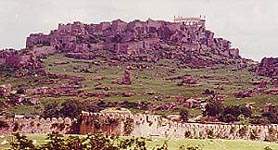
The fortress of Golconde
The Charminar
This monument, in the shape of an arch of triumph, was erected in 1591 by the founder of Hyderabad, Mohammed Quli, to celebrate the end of an epidemic of plague. The four columns, surmounted by minarets, measure 49 meters high and the arches are oriented to face the 4 cardinal points.
The Charminar district is famous for its bazaars, including Laad Bazaar, where you can find all kinds of goods (beads, perfumes, saris, jewelery, etc.)
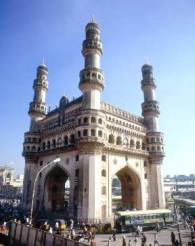
The Charminar
The Mecca Masjid
It is one of the largest mosques in the world. Its construction began during the reign of Mohammed Quli in 1614 but it was not completed until 1694 after the annexation of the city by Aurangzeb. Bricks would have been brought from Mecca for the construction of the central arch, hence its name.
It can accommodate nearly 10,000 faithful.
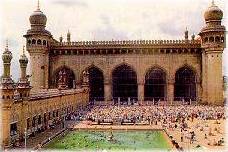
The Mecca Masjid
The tombs of the Qutub Shahi kings
These mausoleums house the tombs of the seven kings of the Qutub Shahi dynasty. In the center of the mausoleums is a sarcophagus below which a crypt has been dug. The domes were formerly covered with blue and green tiles. In the time of the Qutub Shahi, tombs were considered as refuge, even for criminals, but they fell into disrepair after their reign. They were restored in the 19th century.
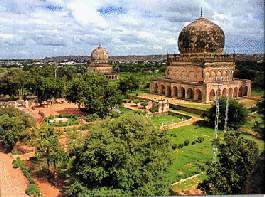
The tombs of the Qutub Shahi kings
The Salar Jung Museum
The building is named after Salar Jung Bahadur, Prime Minister of the nizam of Hyderabad in the 1850s. He was an indefatigable collector of antiquities and objects brought back from the Far East in particular. One of his most beautiful pieces is a translucent marble statue of Bezoni, an Italian sculptor.
The museum now houses more than 35,000 pieces (carpets, miniatures, diamonds, weapons, ivories, sculptures, engravings, etc.) and more than 50,000 books.
The temple of Sri Venkateswara
Also called Birla Mandir, this temple was built in 1976 at the top of Kala Pahad Hill. It was built with 2000 tons of white marble. Its architecture is a mixture of the style of the North and the style of the South.
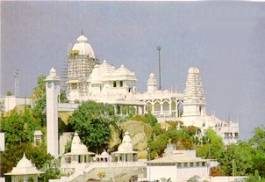
The temple of Sri Venkateswara
The Tomb of Raymond
Here rests the French mercenary Michel Joachim Marie Raymond. Born in 1755, he arrived in India in 1786 and offered his services to the nizam of Hyderabad. He quickly became popular with Hindus and Muslims. When he died 12 years later he was head of 19,000 men.
Warangal
Warangal was the capital of the Kakatiya kingdom in the twelfth and thirteenth centuries. It was conquered by the Tughluq of Delhi in the 14th century. The Kakatiya were great builders and many temples testify to the architectural evolution of the Chalukya period. Warangal is known for its wool and cotton market.
The fort of Warangal
The construction of this impressive fortress began under King Ganapathi in 1199 and was completed by his daughter Rudrama in 1261. It has three enclosure walls. Four doors are oriented towards the cardinal points. They are similar to those of Sanchi, which testifies to a certain Buddhist influence. A temple once stood in the center of the fort.
The temple with a thousand pillars
This temple was built in 1163 in the Chalukya style and dedicated to Shiva, Vishnu and Surya. As the name suggests it is adorned with magnificent finely carved pillars. The ceilings and portals are decorated with figures of gods and goddesses. A superb Nandi in black basalt lies within it.
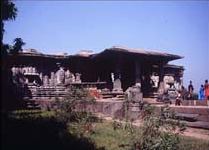
The temple with a thousand pillars
The temple of Bhadrakali
The main attraction of this temple is the statue of Kali. It is represented sitting, with eight arms each carrying a weapon. According to the legend King Pulakesan II came to pray there before going to fight.
Vijayawada
Vijayawada is the second largest city in Andhra Pradesh. It is considered the heart of the state. The purest form of the telougou is spoken here and the great movements of political thoughts were born in Vijayawada. Legend has it that Arjuna, the hero of the Mahabharata, came here to pray Shiva as an ascetic. Shiva appeared to him and rewarded him. It was in memory of this meeting that the place was baptized Vijayawada (City of Victory).
The city is an important crossing point and a large industrial center.
The rock temples of Undavalli
Located 8 km from the city, these temples were carved out of granite in the 7th century. One of them houses a statue of Vishnu lying 5 meters long. (To see it you have to ask the guard to open the door!)
The other temples are dedicated to Brahma, Vishnu and Shiva.
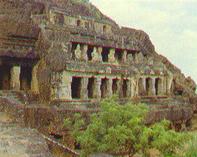
The rock temples of Undavalli
The temple of Kanaka Durga
This temple is dedicated to Durga, protective goddess of Vijayawada (Kanaka Durga means "Golden Durga"). It is said that the Sri Chakra Yantra (sacred geometric figure) was placed here by the great philosopher Adi Sankara. The goddess is depicted with her eight arms killing the demon Mahishashura.
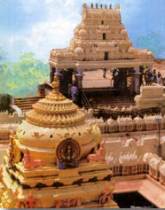
The temple of Kanaka Durga
The Prakasam Dam
This 1223-meter-long building built on the Krishna River was completed in 1957. As early as 1841, the English had the idea of its construction, which they finally engaged in 1855. After independence a new dam was built. The authorities gave him the name of the first Prime Minister of Andhra Pradesh, Tanguturi Prakasam.
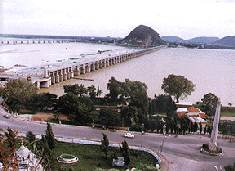
The Prakasam Dam
Tirumala and Tirupathi
This place is known all over India for its temple of Venkateshwara. Perched on a high hill of 874 meters, the temple is a masterpiece of Dravidian architecture. It is a great center of pilgrimage. It was already a place of worship under the Pallava and the Chola in the 10th century. All the great dynasties came to leave their traces there by adding walls. The holy of holies, with its gilded roof, is open to non-Hindus. It houses a performance of Venkateshwara. It measures 2 meters high and has 4 arms. Some people think it has the attributes of Vishnu and Shiva.
There are always a great number of pilgrims (from several thousand to several tens of thousands). The staff of the temple alone has 18,000 employees. The temple of Venkateshwara is one of the richest in India. It thus finances the construction or operation of universities, hospitals, orphanages, reception centers for pilgrims, etc.
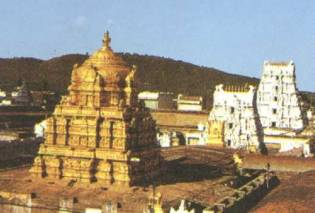
The temple of Venkateshwara
Lepakshi
Lepakshi is an important pilgrimage center. The place where the city rises is indeed cited in the Ramayana. According to legend, it was there that the bird Jatayu fought against the demon Ravana who had just kidnapped Sita, the wife of Rama. The fight ended in the defeat of Jatayu, wounded mortally. Rama heard this and went to the scene. He gathered the last words of the bird and to thank him, Rama celebrated the obsequies and granted him the moksha pronouncing the words "The Pakshi".
Between the fifteenth and sixteenth centuries, Virupana, who was treasurer of one of the Vijayanagar kingdoms, built the temple of Veerabhadra at Lepakshi, which he dedicated to Shiva. He hired the best artists of the time, but the expenses exceeded his means and he had to divert money from the royal taxes. The temple is a wonder in the purest style Vijayanagar. Numerous sculptures and murals adorn the temple. Some works deserve more attention than others in particular the Saptaphani Nagendra, the Antariksha Sthamba and the monolithic Nandi.
- The Saptaphani Nagendra: a monolithic sculpture depicting a seven-headed snake whose coiled body supports a black lingam (pictured left).
- The Antariksha Sthamba: it is a pillar whose base seems to touch the ground while it is actually suspended from the ceiling.
- The Nandi: this huge monolithic sculpture 4.5 meters high and 8.2 meters long would be the most important representation of the Shiva mount in India and also one of the most beautiful of its kind.
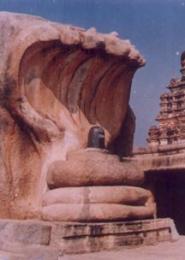
The Saptaphani Nagendra
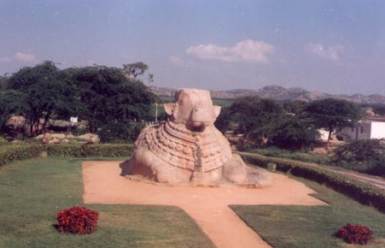
The Saptaphani Nandi
See also:





